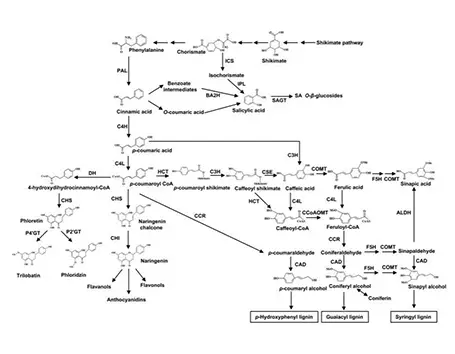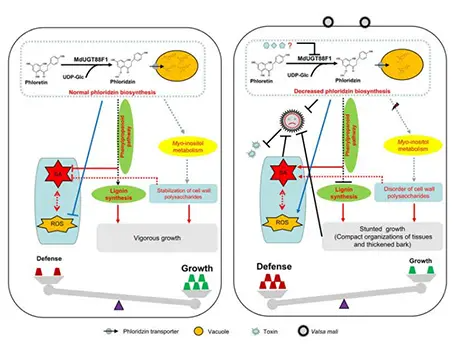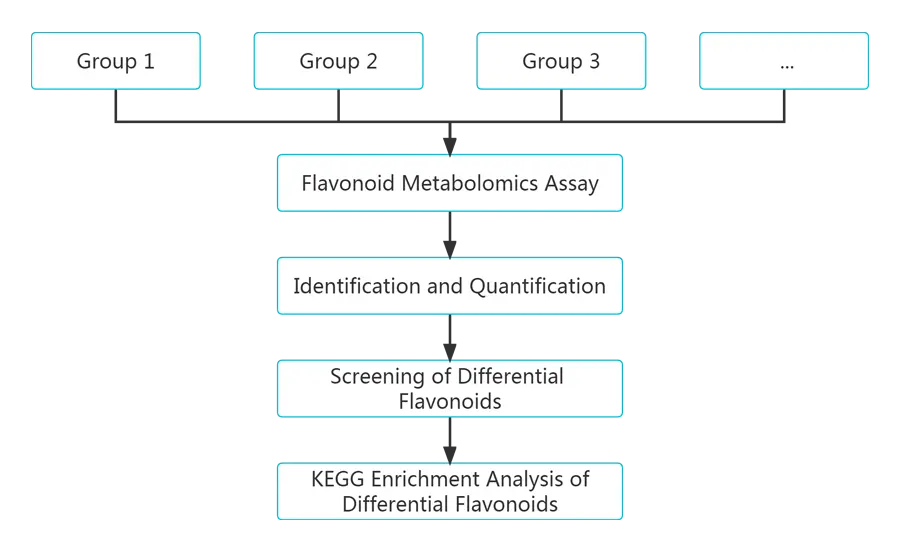Flavonoids Metabolomics
Flavonoids Metabolomics
Technology Introduction
Technology Features of Flavonoids Metabolomics Service
Applications of Flavonoids Metabolomics Service
- HPLC analysis of flavonoids metabolites from plant samples.
- Abiotic stress research (e.g. drought resistance, cold resistance, etc.).
- Research on plant growth, reproduction, and development (e.g. differentiation, maturation, aging, apoptosis, etc.).
- Biological stress response research (e.g. pathogen and insect resistance).
- Research on plant nutrients and colours.
-
MdUGT88F1-mediated phloridzin biosynthesis regulates apple development and Valsa canker resistance
Phlorizin is the predominant dihydrochalcone in apples, and its content accounts for about 90% of soluble polyphenols in leaves. The biological functions of phlorizin are still unknown. The diversity (content and species) of dihydrochalcone in apple germplasm resources was used to identify the key glycosyl transferases (phloretin 2'-O-glucosyltransferase), MdUGT88F1, which catalyzes the synthesis of phloretin in apples. When MdUGT88F1 was disrupted by RNAi, the reduced phlorizin, which regulates the phenylpropane pathway, indirectly caused the reduction of lignin synthesis; At the same time, by indirectly reducing the inositol content, it caused changes in the pectin composition of the plant cell wall. Through the above effects, the plant exhibited disturbed cell wall deposition and showed stunted growth and development. In MdUGT88F1-RNAi plants, the reduction of phlorizin content not only directly restricted pathogenic bacterium growth and toxin generation but also mediated the accumulation of SA and ROS by indirectly interfering with cell wall deposition. Enhanced tissue compactness and large accumulation of SA and ROS directly limited the infestation of V. mali. As the growth and development of interfered plants were suppressed, but also increased the ability to resist diseases.

Graph1. Biosynthesis of salicylic acid, lignin and phlorizin

Graph2. Model of MdUGT88F1-mediated phloridzin biosynthesis regulates apple development and Valsa canker resistance
References:
Kun Zhou, Lingyu Hu, et al.MdUGT88F1-mediated phloridzin biosynthesis regulates apple development and Valsa canker resistance. Plant Physiology.2019.
Analysis Content Display of Flavonoids Metabolomics Service
Sample Requirements Of Flavonoids Metabolomics Service
1. Sample submission instructions
a. Leaf, stem, flower, and other tissues: After removal, immediately put them into liquid nitrogen for more than 2min of snap-freezing, and then transfer them to -80°C for storage in order to avoid repeated freezing and thawing. ( Cut the larger leaves up quickly with scissors.)
b. Underground tissues (eg. stems, tubers, roots): Rinse the separated samples with sterile water and dry the samples with paper. Quickly and snap-freeze in liquid nitrogen for 2 min and transfer them to -80℃ for storage. Tissues such as tubers are suggested to be cut into 1-2cm cubes.
c. Fruit pulp and skin tissues: If the field site does not have separation conditions, it is best to take the samples in-door as soon as possible (within 30min). Cut the samples into 1-2 cm pieces under a low-temperature environment and snap-freeze in liquid nitrogen for 2 min. Transfer to -80C for storage.
d. Cells: Pellet the cells and remove the supernatant. Snap-freeze the samples in liquid nitrogen for 2 min and transfer to -80C for storage.
2. Mix Sampling
In order to ensure the accuracy of the samples and reduce systematic errors, we recommend combining samples from more than 3 plants of uniform growth as a single sample. Using rice leaves as an example: From 6 individual rice plants with the same growing period, take one leaf each from the same part of the plant, and mix all 6 leaves in one tube followed by snap-freezing in liquid nitrogen.
3. Sample Size and Biological Replicates
a. Fresh samples should have a minimum of 3g, dry samples should have a minimum of 1g, and cell samples should have at least 10^7 cells in each sample.
b. Have a minimum of 3 biological repeats in each group. We recommend having extra samples as backups.
4. Storage and transportation
Please store the samples at -80°C prior to shipment. Allow sufficient dry ice for transport and avoid repeated freezing and thawing. We recommended preparing 5kg of dry ice per shipping day.
Next-Generation Omics Solutions:
Proteomics & Metabolomics
Ready to get started? Submit your inquiry or contact us at support-global@metwarebio.com.



